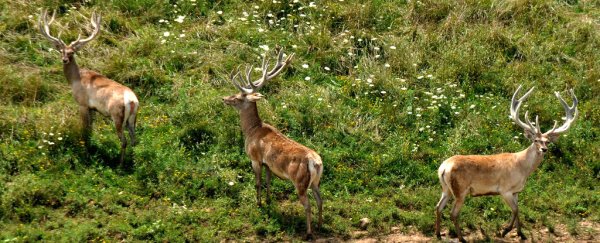Researchers have spotted the rare Bactrian deer (Cervus elaphus bactrianus) in the wild in Afghanistan for the first time in more than 40 years. Until now, scientists had feared that the dwindling species had become extinct in the region, after two major wars and years of civil conflict.
The last time the animals had been surveyed in the wild was during the 1970s, and there were only around 120 individuals left in a small pocket in the northeast corner of Afghanistan.
That's the Takhar Province, near Tajikistan, which was on the border of the USSR during the Soviet-Afghan War in the late 1970s, and then was taken over by Mujahedeen leaders in the '80s.
"That area was not safe," one of the conservationists who recently spotted the deer, Zalmai Moheb from the University of Massachusetts, told Joshua Rapp Learn from the Smithsonian.
"The Mujahedeen was fighting the Soviet Union … Because of this instability, every household had a gun."
Researchers had feared the worst, seeing as the deer's range was already so limited on the Afghanistan side of the border.
But an expedition in 2013 identified hoof prints and droppings from the species, and eventually a fleeting glimpse of a young female deer. The team has just published their results in the Deer Specialist Group newsletter of the International Union for the Conservation of Nature.
"It was a great feeling," said Moheb. "Wow, we're going to confirm the species here for the first time after 45 years. That will be a big thing for the wildlife in Afghanistan."
While there hasn't been constant fighting in the Takhar Province of Afghanistan, there's been regular conflict with warlords and smugglers, and the arming of the local population means that deer were often hunted for sport or food.
The researchers aren't sure how many Bactrian deer are now living in Afghanistan, though they note that they're limited to a remote 280-square-kilometre floodplain that's cut off from roads by the Amu Darya River, and urgently need conservation to protect them in future.
The good news is that the Bactrian deer is also found in Kazakhstan, Tajikistan, Turkmenistan, and Uzbekistan, and the global population has increased from just 350 to 400 in the 1960s to around 1,900 wild animals in 2011, thanks to local conservation efforts.
But the Afghanistan population has been mostly ignored due to conflict in the region.
The researchers hope that their discovery that the Afghan deer are still around and have outlasted multiple local regimes to take their place the ultimate survivors will inspire people to protect them in future - despite the fact that the local political situation is still tumultuous.
"If you wait for one thing to be over to start, at that time you may lose it," Moheb told the Smithsonian.
